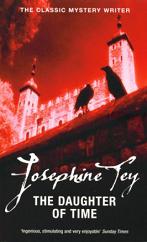
The Daughter of Time
Josephine Tey
189 pages
Published in 1951
Read more about:
Josephine Tey,
Richard III,
book review
I first encountered Josephine Tey's writing with The Singing Sands and was not impressed. It was only an average mystery but what was worse was that Josephine Tey turned out to be an incredibly parochial, insular writer, utterly convinced of the superiority of everything English and condescending of everything that is not. She is also with strong opinions about a lot of them and quite a lot of these opinions are either dated or downright stupid. You may think it strange than that I would read another of her mysteries, but The Daughter of Time is supposed to be her best one, the one with which she transcended herself, the one for which she is remembered. It is also why I tried The Singing Sands in the first place, as Tey's name had come up in conversation with people usually reliable in their book recommendations, with The Daughter of Time singled out for particular praise. Singing Sands was just the first of her books I could put my hands on.
The Daughter of Time shares the same protagonist as The Singing Sands, inspector Alan Grant. In this novel he has landed in hospital after a back injury sustained while trying to catch up to a burglar. Lying in hospital on his back bored out of his skull, none of the books he brought to the hospital appealing, and complaining loudly about this to his visitors, until one of them suggests he'd try his hands at solving one of history's unsolved mysteries. Several suggestions are made, but it is while glancing at a portrait of Richard III that Grant has his mystery to solve: did Richard III murder the two princes in the Tower or was he framed?
For Josephine Tey --and hence Alan Grant-- the answer is clear: he was framed; The Daughter of Time is therefore a redemption attempt for one of the most notorious villains in English history, showing that the crimes he had allegedly committed are no more than Tudor propaganda, done to secure their grip on the throne. She proves this by letting Alan Grant "solve" it as he would've any other murder mystery, by looking at the facts in the case and then deducing the true murderer from them. Much of the strength of the book comes from Tey's deepseated conviction that Richard III was innocent.
The Daughter of Time was Josephine Tey's last novel and probably also her best. The novelty of solving a historical mystery thrumps much of Tey's weaknesses as a writer and in fact much of the things that annoyed me about The Singing Sands are much muted here. Therefore, if you need to read one Josephine Tey novel, make it this one.
